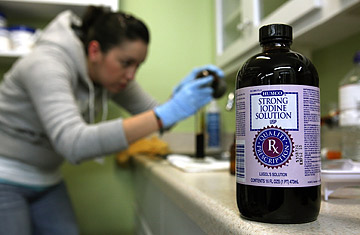
A worker at West Marin Pharmacy fills vials with iodine solution in Point Reyes Station, Calif., on March 15, 2011
The good news in Japan was that the winds had been pushing the radiated plumes from the stricken Fukushima Daiichi nuclear power plant out into the Pacific Ocean, away from populated areas. The winds would likely prevent more harm from happening to the earthquake-and-tsunami-battered region.
But that didn't seem like altogether good news to people on the West Coast of the U.S., where there is now a run on potassium iodide. The tablets can help block the absorption of radioactive iodine. The California Department of Public Health and the California Emergency Management Agency have urged residents to not take potassium iodide as a precautionary measure because it can cause serious side effects. But the warnings have not stopped Californians from rushing to buy the pills, creating a backlog at the companies that produce them.
The West Coast, and particularly California, shares many of Japan's vulnerabilities, including the risk of earthquakes and tsunamis. But with two nuclear reactors located in California, radiation might be the scariest potential threat in the minds of many because it is intangible — an invisible, ghostlike killer.
West Coast residents like DJ Shark ("You can just call me Shark") have been following the news, and while they're not exactly panicking, they're not feeling totally safe. Shark is a musician. His band's music has been in a lot of movies. He lives in West Hollywood.
A couple of days ago, he joked with his girlfriend that they should take a trip to Arizona. Shark wasn't immediately concerned about a deadly nuclear release hitting Los Angeles. But on Facebook he started telling his friends to update their earthquake kits to include potassium iodide. He started searching for the pills on websites so that he could stock his own kit, he says, in the event that "clouds started forming, a siren went off to go inside and the rain started falling."
The price of the pills had shot up from $6 a bottle to $140, and most online sources had sold out. "I am not Mr. Paranoia, but we are watching a worst-case scenario in Japan, and they have good safety measures," says Shark. "I don't have the same trust in the United States. Look at the Gulf Coast disaster. It was a level of technical incompetence, but it also showed poor regulatory measures."
Californians have many questions about what exactly is emanating from the Japanese plant — and how it might affect them. It is a small world, after all. Where might nuclear radiation drift? Can something so toxic just dissipate into thin air, forgotten for eternity?
Scientists believe the radioactive dust and gases from Japan won't reach U.S. shores at a dangerous level. But in many a worried West Coast mind, a tsunami raced across the Pacific at the rate of a jet, so it is not inconceivable to imagine the prevailing winds carrying plumes of deadly dust into the airstream, across Hawaii and toward the West Coast. To many people waking up to the continuous bad news from Japan, it seems like a Japanese disaster might turn into a global one. In an overheard conversation at a Santa Monica coffee shop, a woman told a person sitting nearby that a "friend on the Internet said that radiation would hit L.A. in 10 days."
Because nuclear bombs are so frightening and reactor disasters so profound, a lot of healthy concern swirls around anything nuclear. But scientists say problems with the Japanese reactors would affect only people in the immediate area: when there is a meltdown, radioactive dust tends to settle to the ground near the compromised reactor. Small particles travel farther, but "imagine the transport of the particles over many thousand kilometers," says Ferenc Dalnoki-Veress, a research scientist at the James Martin Center for Nonproliferation Studies at the Monterey Institute of International Studies. "It is just not possible to imagine the plume would stay intact long enough over such long distances to cause a concentrated dose. Just imagine a smokestack releasing a cloud which at first looks like a thick, billowing cloud but soon peters out, and you can't even see it anymore — that's how I see this plume. As the distance increases, the particles become smaller and less concentrated." So radioactive gases could reach U.S. shores, but by the time they arrived, the concentration levels would be greatly diminished and not dangerous, Dalnoki-Veress says.
The public in California is not easily convinced, however. There is a gloomy sense that the real story hasn't totally emerged, that bureaucrats always cover up the worse news during a disaster. Adding to the conspiratorial mix, pro- and anti-nuclear groups have spent the past decades vilifying one another, so the public doesn't know what to believe about nuclear energy. Up and down the West Coast, people are staring at their televisions, searching meteorological maps, reading news about Japan and even looking to the sky, hoping that there is no dangerous radiation headed their way.
